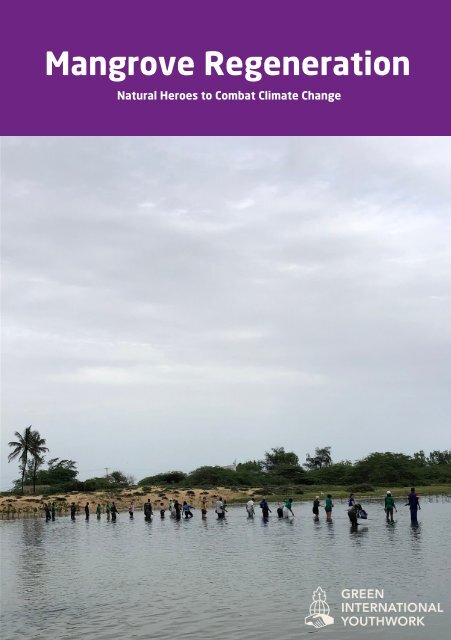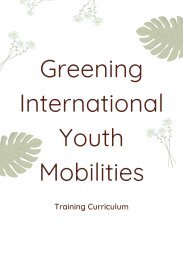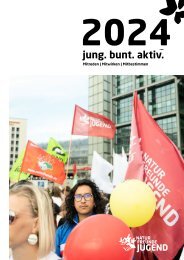Mangroves- natural heroes to combat climate change
Create successful ePaper yourself
Turn your PDF publications into a flip-book with our unique Google optimized e-Paper software.
Mangrove Regeneration<br />
Natural Heroes <strong>to</strong> Combat Climate Change
Porte du Troisième millénaire, Dakar<br />
Table of contents<br />
1.Introduction................................................................................................................................................2<br />
2.<strong>Mangroves</strong> - a <strong>natural</strong> <strong>climate</strong> hero....................................................................................................3<br />
3.Importance of mangroves.......................................................................................................................4<br />
4.Types of mangroves..................................................................................................................................7<br />
5.Let's plant..................................................................................................................................................11<br />
6.Impact - how <strong>to</strong> calculate the carbon compensation..................................................................12<br />
7.Offsetting and insetting CO 2 .................................................................................................................13<br />
8.Examples of successful projects.........................................................................................................16<br />
9.Conclusion.................................................................................................................................................18<br />
10.References.................................................................................................................................................19
Mangrove plantation, Sor Diagne, Saint Louis<br />
Introduction<br />
This mangrove regeneration paper aims <strong>to</strong> provide youth organisations with the <strong>to</strong>ols,<br />
information, and inspiration needed <strong>to</strong> make their youth mobilities more sustainable by<br />
saving and actively compensating CO 2 emissions.<br />
Sustainable mobility is a <strong>to</strong>pic that we all have <strong>to</strong> care about. As youth organisations, this<br />
has <strong>to</strong> be a self-evident part of our agendas, if we aim <strong>to</strong> create a just and sustainable future<br />
for young people. The way in which youth organisations carry out their activities and<br />
mobilities serves as a model, and connects and inspires young people.<br />
The emissions in the <strong>to</strong>urism and transportation sec<strong>to</strong>r increase yearly, aggravating the<br />
<strong>climate</strong> crisis and its consequences, which lead <strong>to</strong> <strong>climate</strong> injustice. In order <strong>to</strong> act against<br />
this injustice, this publication will give an overview of the <strong>to</strong>pic of reducing and<br />
compensating CO 2 emissions, and present good practice examples for trainers, youth workers,<br />
and youth leaders <strong>to</strong> include carbon compensation actions in their activities.<br />
This publication was produced in the frame of the project “Green.International.Youthwork.” -<br />
which aims <strong>to</strong> raise awareness about the <strong>climate</strong> impact of international youthwork and how<br />
<strong>to</strong> improve it - by the partnership consortium consisting of Naturfreundejugend Deutschlands<br />
(Germany), Association Sénégalaise des Amis de la Nature (Senegal), International Young<br />
Naturefriends (Czech Republic), GIAN-Gruppo Italiano Amici della Natura (Italy) and<br />
Biodiversa (Spain). During a youth ex<strong>change</strong> between these organisations, 18 young people<br />
from these countries traveled <strong>to</strong> Senegal, where they participated in the regeneration of<br />
mangrove forests and discussed the <strong>to</strong>pic of reducing versus compensating CO 2 emissions.<br />
Keep reading <strong>to</strong> find out more about it.<br />
The youth ex<strong>change</strong> and this mangrove regeneration paper were kindly<br />
funded by the Erasmus+ programme of the European Commission.
Rhizophora mangroves<br />
<strong>Mangroves</strong><br />
A <strong>natural</strong> <strong>climate</strong> hero<br />
Climate <strong>change</strong> resulting from <strong>natural</strong> disturbances and unsustainable production and<br />
consumption patterns has had a negative impact on the livelihoods of current and future<br />
generations.<br />
According <strong>to</strong> the Department of water, forests, hunting, and soil conservation of<br />
Senegal 1 , over the last half-century, 30-50 % of mangrove forests in Senegal have<br />
disappeared. This matter is of great environmental concern. While all ecosystems are<br />
important <strong>to</strong> our survival, the mangrove, covering just 1 % of the world's tropical forests,<br />
offers invaluable ecosystem services <strong>to</strong> humanity (Afonso, Filipa, et al, 2021). 2<br />
The mangrove is an amphibious forest ecosystem found on most of the world's tropical and<br />
subtropical coasts. Characterised by muddy soil on deltas, riverbanks, lagoons, and seashores,<br />
this eco<strong>to</strong>ne is an intermediate space between the terrestrial and marine environments,<br />
where mangroves proliferate.<br />
Requiring an average annual temperature of 20°C or more, this environment, periodically<br />
subjected <strong>to</strong> the tidal cycle of brackish waters (water whose salinity is between that of fresh<br />
and marine water), is home <strong>to</strong> a flora that may not be very diverse, but which is itself home<br />
<strong>to</strong> a rich and varied fauna.<br />
In this chapter we are going <strong>to</strong> introduce the different species of mangroves, as well as<br />
explain their functions from the ecological, economic, and social perspectives.
Importance<br />
Ecological function<br />
<strong>Mangroves</strong> are some of the most productive coastal systems on the planet and provide<br />
2<br />
valuable ecosystem services (Afonso et al. 2021) .<br />
They stabilise soils and provide nurseries for fish and crustaceans, while endemic and<br />
migrating waterfowl nest in their branches. As a reservoir of biodiversity, mangroves provide<br />
a means of subsistence for the coastal communities, whose diets rely heavily on the<br />
fishfishes and seafood that live within the mangrove ecosystems.<br />
Its enormous network of submerged roots acts as a sediment filter, preserving the quality of<br />
watercourses, and safeguarding various crucially important living organisms in the vicinity,<br />
such as coral reefs.<br />
<strong>Mangroves</strong> provide coastline protection by dampening waves and reducing the impact of<br />
wave action, <strong>to</strong>rrential s<strong>to</strong>rms, and tsunamis (Kamil et al. 2021) 3 .<br />
They are also huge carbon dioxide reservoirs, capable of sequestering 3 <strong>to</strong> 4 times more<br />
atmospheric carbon than a tropical forest. Carbon is s<strong>to</strong>red in the leaves, stems, roots and<br />
soil. Carbon sequestration lowers the C O 2 concentration in the atmosphere, making it a vital<br />
process for decelerating the <strong>climate</strong> crisis.<br />
On average, mangroves sequester 1.4 giga<strong>to</strong>ns of carbon dioxide per square kilometer per<br />
year. Overall, mangroves have a global cumulative sequestration potential of 24.0 ± 3.2<br />
million <strong>to</strong>nnes of carbon per year (Bertram et al., 2021) 4 .
Khor, September 2022<br />
Economical function<br />
The economic impact of mangroves is indisputable, as they represent the daily livelihood of<br />
vulnerable communities in many coastal regions.<br />
Local community<br />
<strong>Mangroves</strong> provide an essential source of income and livelihood <strong>to</strong> local populations, through<br />
timber harvesting, shellfish gathering, aquaculture, beekeeping, fishing and more. They<br />
provide a rich and varied diet for local populations.<br />
Many commercially important species of crustaceans, molluscs and fish reproduce, feed and<br />
grow in mangroves, as their intricate roots serve them as a refuge from preda<strong>to</strong>rs.<br />
Tourism<br />
<strong>Mangroves</strong> are a unique bio<strong>to</strong>pe as they serve as an ornithological sanctuary and breeding<br />
ground for animal species. This makes them a very attractive destination for <strong>to</strong>urists. The<br />
<strong>to</strong>urism sec<strong>to</strong>r around mangroves has been constantly growing in the past years. Therefore, it<br />
is important <strong>to</strong> support the growth of mangrove <strong>to</strong>urism, while ensuring that it does not<br />
harm the very ecosystems that fuel it.
Sor Diagne, Saint Louis<br />
Social function<br />
<strong>Mangroves</strong> are of utmost importance also for the socio-cultural life of the local population<br />
where mangroves are planted.<br />
Medicine<br />
<strong>Mangroves</strong> are biochemically unique and produce a wide array of novel <strong>natural</strong> products and<br />
are considered a rich source of steroids, triterpenes, saponins, flavonoids, alkaloids, and<br />
tannins. They can therefore serve as a <strong>natural</strong> source of medicine that can cure different<br />
illnesses, and are part of the <strong>natural</strong> medical approach of countries like Senegal.<br />
Different parts of the plant can be used for extracting medicines, for example the leaves,<br />
stems, bark, and roots.<br />
Cultural Function<br />
In some cultures mangrove forests are a place for conducting cultural ceremonies such as<br />
cultural education, but also funerals and offerings. <strong>Mangroves</strong> therefore have an important<br />
role in the cultural and social life of the local population, which has <strong>to</strong> be protected from<br />
mass <strong>to</strong>urism.
Propagules harvest, Bango<br />
Types of <strong>Mangroves</strong><br />
Red <strong>Mangroves</strong><br />
The red mangrove (Rhizophora mangle) grows on the seashore in deep water, forming shrubs<br />
up <strong>to</strong> 8 m high. It can be recognized by its elongated propagules and stilt roots with lenticels,<br />
the tiny buds visible on the surface of its roots, which can overcome anoxia by drawing<br />
oxygen from the air. Its leaves are thick, blunt at the tip, and have no conspicuous glands. It<br />
is a facultative halophilic plant, meaning it is resistant <strong>to</strong> salinity but can also grow in a nonsaline<br />
environment. It even <strong>to</strong>lerates water with 90g/l salt, which is 2.5 times saltier than<br />
seawater.
Seedlings of red mangrove<br />
Black <strong>Mangroves</strong><br />
The black mangrove (Avicennia germinans) is set back slightly from the red mangrove in a<br />
zone of shallow water, and can be recognized by its aerial roots called pneuma<strong>to</strong>phores, root<br />
outgrowths emerging straight from the ground and equipped with salt filters, which enable<br />
these trees <strong>to</strong> capture oxygen from the air when they are not covered by water. Its leaves are<br />
elliptic-lanceolate and excrete excess salt <strong>to</strong> the leaf surface, where salt crystals form.
Avicennia flowers<br />
White <strong>Mangroves</strong><br />
The white mangrove (Languncularia racemosa) can be recognized by its <strong>to</strong>ugh, oval, heartshaped<br />
leaves. It grows in the low-salt environment of the mangrove hinterland, forming<br />
shrubs up <strong>to</strong> 3 m high. It sometimes has pneuma<strong>to</strong>phores.
Conocarpus flowers<br />
Grey <strong>Mangroves</strong><br />
The grey mangrove (Conocarpus erectus) or but<strong>to</strong>n mangrove, located higher up in sandier,<br />
less salty areas, can be recognized by its but<strong>to</strong>n-shaped fruits. It is not very abundant and is<br />
especially common along beaches. It has no supporting roots or pneuma<strong>to</strong>phores. It is<br />
shrubby along the shore, but becomes tree-like further inland. There are two varieties:<br />
erectus, with shiny green leaves, and sericeus, with silvery leaves
Mangrove propagules planting, Langue de Barbarie, Saint Louis<br />
Let's plant<br />
4- step plan <strong>to</strong> plant mangroves<br />
Get prepared! Check if the place you identified <strong>to</strong> be the space for your new<br />
mangrove forest is suitable. It should be a muddy soil for them <strong>to</strong> grow. Don't<br />
forget <strong>to</strong> prepare your participants with everything they need like knowledge<br />
and equipment.<br />
Get on board! Take a boat <strong>to</strong> search for ripe mangrove propagules and collect<br />
them in bags. Don't forget <strong>to</strong> check them and select the ones with the best<br />
quality <strong>to</strong> be planted.<br />
Let's plant! Take each propagule and press it in the soil. One-third of it should<br />
be undergound. Then walk two steps forward and press another propagule in<strong>to</strong><br />
the soil. Repeat until you have planted all of them.<br />
Take care! Observe your mangroves and take care of them. If necessary protect<br />
them from environmental or human influences.<br />
Around three-fourths of the propagules planted become mangroves. So<br />
what are you waiting for? Let's plant a mangrove forest.
Mangrove planting, Sor Diagne, Saint Louis<br />
Impact<br />
How <strong>to</strong> calculate the carbon compensation?<br />
One mangrove tree<br />
sequesters 12.3 kg CO 2<br />
per year<br />
One hectar mangrove forest<br />
sequesters 33.600 kg CO 2<br />
per year<br />
A round trip from Berlin <strong>to</strong><br />
Senegal with one s<strong>to</strong>pover in<br />
Spain emits approx. 951 kg CO 2<br />
In order <strong>to</strong> compensate your flight,<br />
you would need <strong>to</strong> plant approximately 77 mangrove trees within a year.
Propagules harvesting in Langue de Barbarie, Saint Louis<br />
CO 2 Offsetting<br />
or better not?<br />
Carbon offsetting was recommended by the Intergovernmental Panel on Climate Change<br />
(IPCC) in order <strong>to</strong> absorb some of the CO 2 emitted in<strong>to</strong> the atmosphere, as a way <strong>to</strong><br />
compensate for emissions that are supposedly impossible <strong>to</strong> avoid.<br />
This concept has become very popular in people's everyday life. If we are preparing a trip and<br />
we have a closer look when we book our accommodations or transport tickets, we may come<br />
across the possibility of paying a certain amount in order <strong>to</strong> compensate for the CO 2<br />
emissions of our travel.<br />
A whole carbon market has been created around the carbon offsetting concept, and anyone<br />
can buy “carbon credits” <strong>to</strong> compensate for their emissions, making it easier <strong>to</strong> become<br />
carbon neutral. But does this really serve its purpose?<br />
Flaws<br />
The workings of the existing carbon market are highly imperfect. Double counting and<br />
additionality are very common. In “double-counting”, both companies (the one paying for the<br />
offsetting and the one doing it) count the CO 2 reduction. In “additionality”, the company<br />
that’s being paid for, let’s say, planting trees, would have done the planting anyways. In both<br />
cases, more CO 2 reductions are counted than the ones actually reduced.
Propagules planting in Langue de Barbarie, Saint Louis<br />
Just greenwashing?<br />
This mechanism of purchasing "carbon credits" <strong>to</strong> finance projects and programs for reducing<br />
or sequestering greenhouse gases, has been misused and is problematic. It serves the<br />
communication needs of major emitters rather than the <strong>climate</strong>. Polluters give themselves a<br />
clear conscience by redeeming their social acceptability, while continuing <strong>to</strong> pollute.<br />
This unspoken greenwashing then serves as a licence <strong>to</strong> destroy, linking the idea that as long<br />
as you can pay <strong>to</strong> offset, it's permissible and acceptable <strong>to</strong> engage in <strong>climate</strong>-changing<br />
activities.<br />
Unfortunately, in the battle against greenhouse gas emissions there is often an overemphasis<br />
on offsetting as the ultimate solution. Instead, the focus should be on prioritising reduction<br />
and, most importantly, prioritising avoidance. Faced with this excess of CO 2 in the<br />
atmosphere, the choice is no longer between simply reducing and compensating. In order<br />
<strong>to</strong> meet the <strong>climate</strong> challenge we should focus on avoiding emissions. These two measures<br />
(reduction and avoidance) are essential for effectively limiting emissions and, consequently,<br />
playing a more impactful role in the fight against <strong>climate</strong> <strong>change</strong>.<br />
In other words, offsetting or reducing without first thinking about avoiding emissions is<br />
simply greenwashing. For an efficient carbon-neutral policy, you should only offset what you<br />
can't avoid or reduce.<br />
Offsetting is the last resort for unavoidable damage.
What does this have <strong>to</strong> do with <strong>climate</strong> justice?<br />
Low-income countries, the first victims of global warming, with a very low contribution <strong>to</strong><br />
global C O 2 emissions, find themselves bearing the brunt of losses and damage resulting from<br />
the activities of the most industrialized countries.<br />
In the countries of the global South, where most projects are implemented <strong>to</strong> compensate for<br />
emissions from the North, we often note a vertiginous loss of biodiversity, the disruption of<br />
ecosystems, and the trampling of human rights (expropriations, grabbing of huge tracts of<br />
land for monoculture and forced displacement of local populations).<br />
CO 2 insetting<br />
A better solution<br />
Carbon ‘insetting’ focuses on doing more good rather than doing less bad within one’s value<br />
chain.<br />
Insetting is the implementation of nature-based solutions such as reforestation, agroforestry,<br />
renewable energy, and regenerative agriculture <strong>to</strong> capture carbon from the atmosphere.<br />
Some insetting activities also improve the livelihoods of indigenous communities as a result.
Examples<br />
get inspired!<br />
International cooperation<br />
During the "Greening International Youth Work" project funded by the Erasmus + project,<br />
and under the guidance of the conserva<strong>to</strong>r of the Parc de la Langue de Barbarie, a group of<br />
young people from Benin, Senegal, Germany, Italy, Spain, and the Czech Republic harvested<br />
and reforested 2 ha of Rhizophora in the Gandiole region, in cooperation with local people.<br />
This enabled the young people <strong>to</strong> discover mangrove ecosystems, learn how <strong>to</strong> identify good<br />
propagules, and practice reforestation techniques.<br />
If we follow our calculations from before, this means that with this international project the<br />
group was able <strong>to</strong> plant mangroves that will capture around 672.000kg of CO 2 per year, which<br />
is significantly more than what they emitted due <strong>to</strong> their travels (approx. 133.000 kg).<br />
Through this concrete mangrove reforestation activity, this group made a significant<br />
contribution <strong>to</strong> the effort of insetting emissions.
Sor Diagne<br />
Involve your local commnuity!<br />
With funding from Germany's Federal Ministry for Cooperation and Development (BMZ), the<br />
3-year "Reforestation of mangroves for <strong>climate</strong> protection in St Louis Senegal and<br />
Janjanbureh The Gambia" project aimed <strong>to</strong> build the capacity of local communities in<br />
sustainable mangrove management, raise awareness of <strong>climate</strong> issues and strengthen<br />
regional cooperation between Senegal and The Gambia.<br />
A <strong>to</strong>tal of 20 ha of mangroves, 15 ha in Saint-Louis and 5 ha in Janjanbureh, are being<br />
reforested in 4 districts of Saint-Louis (Sor Diagne, Khor, Bango and Bopp Thior) and in<br />
(Balangharr) Janjanbureh/The Gambia, where groups of women and young people in<br />
communities close <strong>to</strong> the plantations are being trained <strong>to</strong> protect the mangrove plantations<br />
sustainably.<br />
At a rate of 5,000 propagules per hectare, the project will have enabled the reforestation of<br />
100,000 mangrove trees (¾ Rhizophora and ¼ Avicennia).<br />
Ultimately, the environmental awareness of the population (women's groups, fishermen, and<br />
students) has increased thanks <strong>to</strong> the acquisition of knowledge about reforestation activities<br />
and sustainable mangrove management.
Conclusion<br />
Act now!<br />
The <strong>climate</strong> crisis is affecting dramatically the livelihoods of the countries of the South,<br />
making them more vulnerable. The rich countries, which are largely responsible for this<br />
ecological disaster, must assume their responsibilities and act now.<br />
We need <strong>to</strong> reduce the concentration of greenhouse gases in our atmosphere, and mangrove<br />
ecosystems are among the most capable of sequestering atmospheric carbon than any other<br />
forest. In the face of rising sea levels, mangrove regeneration in tropical and subtropical<br />
zones is one of the most effective adaptation measures. Safeguarding and res<strong>to</strong>ring these<br />
mangrove ecosystems, with their immense ecological and socio-economic functions, remains<br />
a priority mainly for the rich countries responsible for the <strong>climate</strong> crisis.<br />
It's a question of true <strong>climate</strong> justice <strong>to</strong> strengthen the resilience of the most vulnerable<br />
populations, hardest hit by <strong>climate</strong> <strong>change</strong> <strong>to</strong> which they have contributed a tiny fraction.<br />
Coastal mangrove ecosystems play a fundamental role in <strong>climate</strong> <strong>change</strong> mitigation and<br />
adaptation strategies. The effective protection and enhancement of this bio<strong>to</strong>pe, a larder for<br />
local communities and a living labora<strong>to</strong>ry for scientists, must be an absolute priority for<br />
present and future generations <strong>to</strong> benefit from.
References<br />
1 Direction des Eaux, Forêts, Chasses et Conservation des Sols, Ministère de l’Environnement<br />
et du Développement Durable, Sénégal<br />
2 Afonso, Filipa, et al. "Assessing ecosystem services in mangroves: insights from São Tomé<br />
Island (Central Africa)." Frontiers in Environmental Science 9 (2021): 501673.<br />
3 Kamil, E. A., Takaijudin, H., & Hashim, A. M. (2021). <strong>Mangroves</strong> as coastal bio-shield: a<br />
review of mangroves performance in wave attenuation. Civil Engineering Journal, 7(11),<br />
1964-1981.<br />
4 Bertram, C., Quaas, M., Reusch, T. B. H., Vafeidis, A. T., Wolff, C., & Rickels, W. (2021). The<br />
blue carbon wealth of nations. Nature Climate Change, 11(8), 704–709.<br />
https://doi.org/10.1038/s41558-021-01089-4
Organisations<br />
Asociación BIODIVERSA is a non-profit and non-governmental grassroots environmental<br />
organization based in Asturias, Spain. It provides meaningful learning experiences in nature<br />
for young people and adults since 2011.<br />
Its mission is <strong>to</strong> promote care for nature and the environment through education and<br />
awareness raising. Its vision is a planet in which humans live in harmony with themselves,<br />
each other, and their environment. www.asociacionbiodiversa.org<br />
GIAN-GIO is an informal group within the network of GIAN (Gruppo Italiano amici della<br />
nature) which is a non-profit and non-governmental grassroots environmental organization<br />
based in 4 regions in Italy. GIANGIO’s main pillars are connected <strong>to</strong> solidarity, sustainability,<br />
and non-formal education. Since 2017, GIANGIO has connected young people in Italy <strong>to</strong> other<br />
nations and fights against <strong>climate</strong> <strong>change</strong> on different levels. Its local network reaches 7<br />
localities within small and medium size municipalities. Via this local section, GIAN manages<br />
<strong>to</strong> conduct activities and initiatives that are also promoted <strong>to</strong> increase and improve human<br />
relations by fostering, for example, ex<strong>change</strong> between different cultures, different social<br />
backgrounds and different approaches <strong>to</strong> nature. www.giangiovani.org<br />
As an independent youth organisation, NFJD gets engaged on questions of justice, stand up<br />
for the rights of children, fight for <strong>climate</strong> justice and a sustainable transformation of society.<br />
Democracy and participation are at the heart of our educational work. Young people need <strong>to</strong><br />
be enabled <strong>to</strong> take part in political decision-making. We demand: do not talk about them, talk<br />
with them! We value diversity and we go for colourful and active groups of young people.<br />
Together we explore new forms of living in solidarity and young politic initiatives.<br />
For any questions feel free <strong>to</strong> contact our national office in Berlin:<br />
info@naturfreundejugend.de<br />
ASAN - Association Sénégalaise des Amis de la Nature (Senegal), founded in 1983, is the first<br />
organisation in Africa entirely dedicated <strong>to</strong> nature protection. ASAN aims <strong>to</strong> protect and<br />
res<strong>to</strong>re the environment, end poverty through good management of <strong>natural</strong> resources,<br />
promote sustainable <strong>to</strong>urism, and fight against <strong>climate</strong> <strong>change</strong>. ASAN achieves these missions<br />
through a participative approach and direct collaboration with the communities. ASAN is one<br />
of the funding organisations of "African NaturFriends Networks" (RAFAN) and a member of<br />
the International Naturefriends Movement.<br />
IYNF- International Young Naturefriends (Czech Republic)<br />
IYNF is an international organisation bringing <strong>to</strong>gether Young Naturefriends and their<br />
organisations across Europe. It was established in 1975 and currently has 18 member and 14<br />
partner organisations. With more than 120.000 young members organised in over a thousand<br />
local groups, it is one of the major European youth organisations.<br />
The fundamental reason for IYNF’s existence – or what we jointly want <strong>to</strong> become – is an<br />
international network <strong>to</strong> connect and inspire Young Naturefriends for living values of respect,<br />
solidarity, equality, sustainability and love and care for nature.
Legal notice<br />
This publication was jointly created by:<br />
Naturfreundejugend Deutschlands<br />
Warschauer Str. 59a, 10243 Berlin<br />
www.naturfreundejugend.de<br />
info@naturfreundejugend.de<br />
Association Senegalaise des Amis de la Nature<br />
Route de Petit Mbao, BP 12966 Dakar-Colobane<br />
https://www.facebook.com/naturefriendsUGB<br />
amisnaturesenegal2@yahoo.com<br />
Asociación Biodiversa<br />
C/Ezcurdia 22, piso 13, 33202 Gijón, Asturias, Spain<br />
www.asociacionbiodiversa.org<br />
asociacionbiodiversa@gmail.com<br />
Authors: Mamadou Mbodji, Sina Franz, Esther Vallado<br />
Pictures: Mamadou Mbodji, Naturfreundejugend Deutschlands, qistinamaliks-images, Arthouse, Vec<strong>to</strong>rtradition<br />
This publication was developed as a result of the project "Greening International Youthwork" that was kindly<br />
supported and financed by the Erasmus+ programm of the European Commission.<br />
The opinions expressed in this work are the responsibility of the author(s) and do not necessarily reflect the<br />
official policy or opinion of the donors of this publication.

















